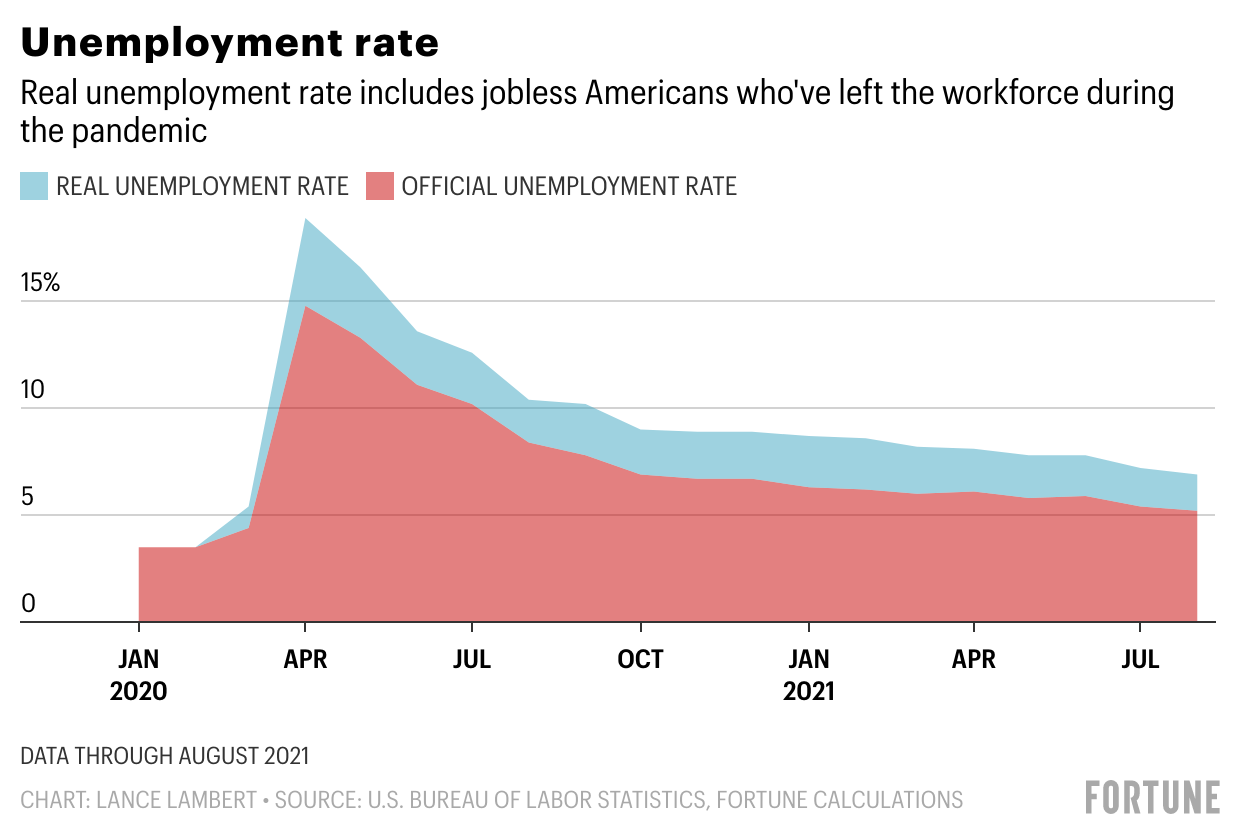美国经济正在复苏?实际情况让人意外
毫无疑问,新冠疫情所引发的衰退给经济带来了毁灭性打击。在2020年春季的两个月中,失业率从50年以来的最低点3.5%飙升至80年以来的最高点14.8%。本季度,美国GDP出现了有史以来最大的跌幅。
不过,这次衰退是来也汹汹,去也匆匆。到2020年5月,经济不仅再次恢复增长,而且增速较快。2020年第三季度见证了美国历史上最大的GDP增幅。在大萧条(Great Recession)时期,经济增速连续59个月高于7%的失业率。这一次,高于7%的增幅仅维持了6个月的时间。到8月,美国失业率为5.2%,非常接近经济学家所认为的美国“充分就业”率。从纸面上看,此次经济反弹是美国有史以来速度最快的反弹之一。
然而,快速的恢复并非像人们看到的那样美好:失业率其实远高于纸面上的经济数据。
这个数据并非伪造或被内部篡改。据此我们可以得出一个结论:美国劳工统计局(U.S. Bureau of Labor Statistics)的经济数据并不完全适用于在新冠疫情期间衡量劳动力市场。
例如,官方失业率的计算方法是:美国失业人数除以劳动力中的员工数。然而,如果一名失业人员并没有寻找工作,他们就不属于任何一个群体。通常来讲,将这类人群排除在外对最终的数字没有太大的影响。然而,在此次新冠疫情期间的情况却有所不同,因为有数百万员工脱离了劳动力大军。
截至8月,民间劳动力数量依然比2020年2月低290万。尽管没有工作,但这290万美国民众都没有被计入官方失业率。如果计算这些已经脱离劳动力大军的个人,那么“实际”失业率就将跃升至6.9%,较官方数字高出1.7个百分点。在2020年4月的危机顶峰,“真实”的失业率达到了18.9%,高出官方数字4.1%。

就像《财富》杂志之前报告的那样,失业员工在大萧条期间脱离劳动力大军是很常见的事情,只是如此规模的脱离在以前从未出现过。在大萧条期间,官方失业率在2009年10月达到了10%的峰值。《财富》杂志的计算显示,如果计算退出劳动力大军的无业员工,那么真实失业率就将飙升至10.6%。不过,这个0.6%的差距与我们在这场危机中所看到的规模相比亦是相形见绌。
为什么如此多的失业员工在新冠疫情危机期间不去找工作?
原因有很多。一些是因为年纪较大或存在感染风险,他们要等到新冠疫情结束之后才会重新开始找工作。有的人则是身为上班一族的父母,通常是母亲,他们有的找不到日托服务,有的则需要居家照看孩子远程学习。
在2020年2月至4月期间,美国有近800万名员工脱离了民间劳动力大军。自那之后,劳动力又增长了500多万,包括8月新增的19万。如果美国维持当前的增速,那么也要到2023年年初才能够回到新冠疫情前的水平。简单来说,劳动力局面正在改善,但在完全恢复之前仍然有很长的路要走。(财富中文网)
译者:冯丰
审校:夏林
毫无疑问,新冠疫情所引发的衰退给经济带来了毁灭性打击。在2020年春季的两个月中,失业率从50年以来的最低点3.5%飙升至80年以来的最高点14.8%。本季度,美国GDP出现了有史以来最大的跌幅。
不过,这次衰退是来也汹汹,去也匆匆。到2020年5月,经济不仅再次恢复增长,而且增速较快。2020年第三季度见证了美国历史上最大的GDP增幅。在大萧条(Great Recession)时期,经济增速连续59个月高于7%的失业率。这一次,高于7%的增幅仅维持了6个月的时间。到8月,美国失业率为5.2%,非常接近经济学家所认为的美国“充分就业”率。从纸面上看,此次经济反弹是美国有史以来速度最快的反弹之一。
然而,快速的恢复并非像人们看到的那样美好:失业率其实远高于纸面上的经济数据。
这个数据并非伪造或被内部篡改。据此我们可以得出一个结论:美国劳工统计局(U.S. Bureau of Labor Statistics)的经济数据并不完全适用于在新冠疫情期间衡量劳动力市场。
例如,官方失业率的计算方法是:美国失业人数除以劳动力中的员工数。然而,如果一名失业人员并没有寻找工作,他们就不属于任何一个群体。通常来讲,将这类人群排除在外对最终的数字没有太大的影响。然而,在此次新冠疫情期间的情况却有所不同,因为有数百万员工脱离了劳动力大军。
截至8月,民间劳动力数量依然比2020年2月低290万。尽管没有工作,但这290万美国民众都没有被计入官方失业率。如果计算这些已经脱离劳动力大军的个人,那么“实际”失业率就将跃升至6.9%,较官方数字高出1.7个百分点。在2020年4月的危机顶峰,“真实”的失业率达到了18.9%,高出官方数字4.1%。
就像《财富》杂志之前报告的那样,失业员工在大萧条期间脱离劳动力大军是很常见的事情,只是如此规模的脱离在以前从未出现过。在大萧条期间,官方失业率在2009年10月达到了10%的峰值。《财富》杂志的计算显示,如果计算退出劳动力大军的无业员工,那么真实失业率就将飙升至10.6%。不过,这个0.6%的差距与我们在这场危机中所看到的规模相比亦是相形见绌。
为什么如此多的失业员工在新冠疫情危机期间不去找工作?
原因有很多。一些是因为年纪较大或存在感染风险,他们要等到新冠疫情结束之后才会重新开始找工作。有的人则是身为上班一族的父母,通常是母亲,他们有的找不到日托服务,有的则需要居家照看孩子远程学习。
在2020年2月至4月期间,美国有近800万名员工脱离了民间劳动力大军。自那之后,劳动力又增长了500多万,包括8月新增的19万。如果美国维持当前的增速,那么也要到2023年年初才能够回到新冠疫情前的水平。简单来说,劳动力局面正在改善,但在完全恢复之前仍然有很长的路要走。(财富中文网)
译者:冯丰
审校:夏林
The onset of the COVID-19 recession absolutely crushed the economy. In a matter of two months in spring 2020, the unemployment rate shot up from a 50-year low (3.5%) to an 80-year high (14.8%). That quarter, U.S. GDP posted its largest ever contraction.
The recession—while fierce—was also brief. By May 2020, the economy was not only growing again, it was growing fast. The third quarter of 2020 generated the largest GDP uptick in U.S. history. During the Great Recession era, the economy was above a 7% jobless rate for 59 consecutive months. This time, it was above 7% for just six months. As of August, we’re at a 5.2% unemployment rate—pretty darn close to what economists consider the nation’s “full employment” rate. On paper, this rebound is one of the fastest on record.
But this speedy recovery isn’t all that it seems: Joblessness is much higher than economic data would suggest.
The data isn’t cooked or intentionally skewed. Instead, it boils down to the fact that the U.S. Bureau of Labor Statistics’ economic data isn’t well-suited to measure a labor market during a pandemic.
See, the official unemployment rate is calculated by dividing the number of unemployed Americans by the number of workers in the labor force. But if a jobless individual isn’t looking for work, they aren’t included in either grouping. Normally, that exclusion doesn’t have a huge impact on the final figure. But it has in this pandemic, during which millions of workers have dropped out of the labor force.
As of August, the civilian labor force count is still 2.9 million lower than it was in February 2020. Despite not having jobs, none of those 2.9 million Americans are included in the official jobless rate. When including those individuals who’ve dropped out of the labor force, the “real” jobless rate jumps to 6.9%. That’s 1.7 percentage points higher than the official rate. At the height of the crisis in April 2020, that “real” jobless rate was 18.9%—or 4.1 percentage points above the official rate at the time.
As Fortune has previously reported, it’s common for unemployed workers to leave the workforce during deep recessions. Still, nothing on the level we’ve seen this go-around has happened before. During the Great Recession era, the official unemployment rate peaked at 10% in October 2009. If you include jobless workers who had dropped out of the labor force, the real unemployment rate for that rate jumps to 10.6%, according to Fortune’s calculations. But that 0.6% difference pales in comparison to what we’ve seen during this crisis.
Why are so many jobless folks not looking for work during the COVID-19 crisis?
There are a number of reasons. Some are older or at-risk Americans who are waiting for the pandemic to end before restarting their job search. Others are working parents—usually mothers—who’ve either struggled to find day care or needed to stay home while their kids learned remotely.
Between February and April of 2020, the U.S. civilian labor force shrank by nearly 8 million workers. Since then, it’s up by more than 5 million—including another 190,000 uptick in August. If the nation sustains its current pace, it would take until early 2023 just to get back to pre-pandemic levels. Simply put: The labor force situation is improving—but we still have a long road ahead to a full recovery.













